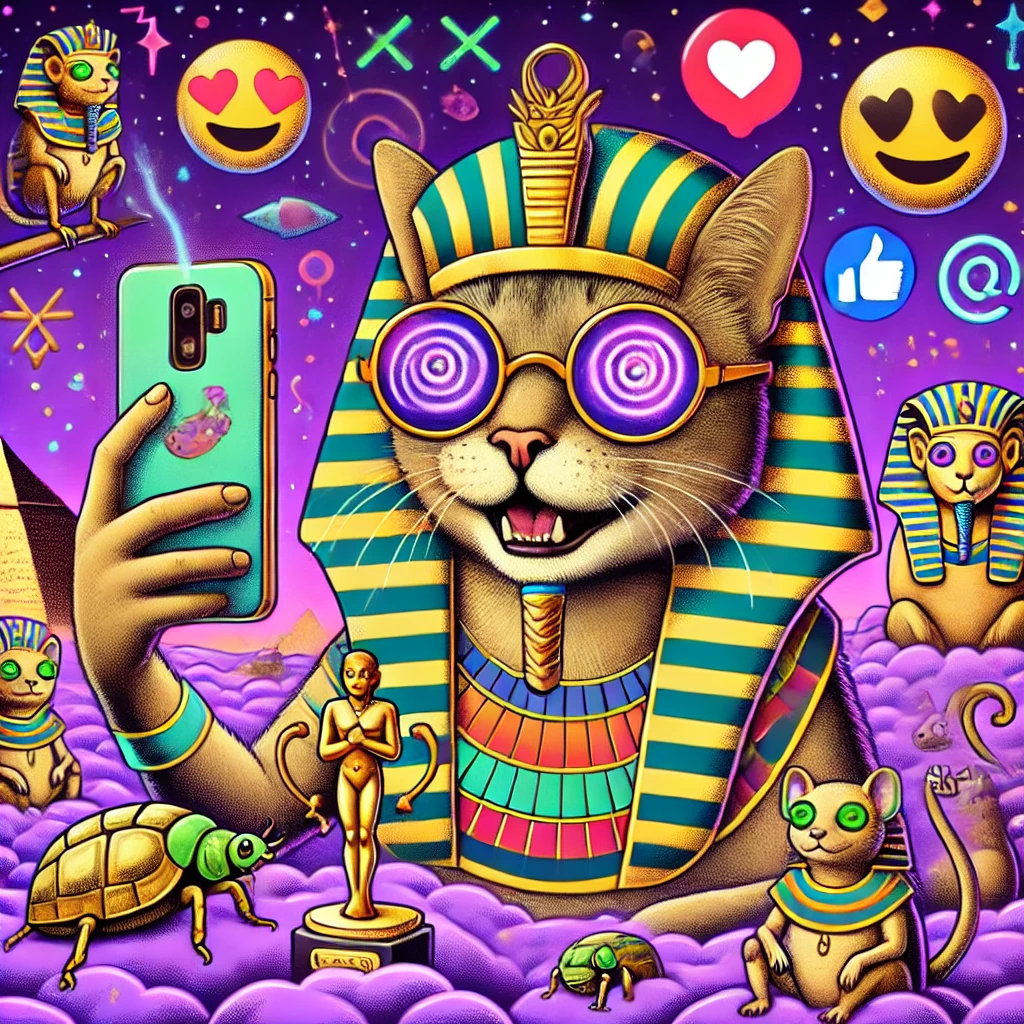Purr-fect Prehistoric Social Media: The OG Cat Content Creators
Have you ever scrolled through Instagram and thought, “Wow, people really love their cats”? (Spoiler alert: Nothing new under the sun, or should we say, under the pyramid.) Ancient Egyptians weren’t just building massive stone structures and inventing mathematics – they were low-key running the world’s first cat appreciation account, thousands of years before hashtags were even a thing.
Picture this: You’re a scribe in ancient Thebes, and instead of taking carefully angled selfies with your feline friend, you’re carving elaborate hieroglyphics celebrating cats as literal divine beings. And we thought modern influencer culture was extra? These folks were taking “cat worship” to a whole new level of commitment. We’re talking about people who spent hours meticulously carving cat portraits into temple walls while probably having actual cats supervising their work. Talk about pressure from your creative director!
From Whiskers to Worship: The Ultimate Viral Marketing Campaign
The ancient Egyptians didn’t just like cats – they absolutely VENERATED them. The goddess Bastet wasn’t just some random deity; she was basically the Kim Kardashian of the animal kingdom, complete with a massive cultural following. (And let’s be real, her brand management was WAY more consistent.) Her temple in Bubastis was like the ancient equivalent of having the most-followed Instagram account, with thousands of pilgrims showing up to pay their respects and probably try to get a glimpse of the sacred cats that roamed the grounds.
Imagine creating content so compelling that your entire civilization decides cats are basically walking, purring mini-gods. That’s not just good marketing – that’s legendary brand positioning. These cats weren’t just pets; they were walking, meowing symbols of grace, protection, and supernatural coolness. Modern influencers could seriously take notes. The ancient Egyptians understood something fundamental about brand building: consistency is key. They didn’t just randomly decide cats were cool one dynasty and then switch to dogs the next. They committed to the bit for literally thousands of years.
Think about it – cats went from being useful mousers to being literally mummified with more care than some humans. That’s what we call a serious brand upgrade. They even had their own makeup artists (kind of) – the priests who would paint their likeness with exquisite detail on tomb walls, capturing their essence for eternity. If that’s not the ultimate filter, what is?
Hieroglyphics: The Original Instagram Stories
Let’s talk about ancient Egyptian social media – aka hieroglyphics. These weren’t just writing; they were aesthetic AF. Each little bird, cat, and geometric shape was like a perfectly curated Instagram grid. You didn’t just read these – you experienced them. The ancient Egyptians understood the power of visual storytelling in a way that would make modern social media managers weep with joy.
When an Egyptian artist carved a cat scene, they weren’t just documenting – they were creating content. Every hieroglyphic was a potential viral moment, telling stories of feline heroism, divinity, and pure sass. And the engagement? Literally carved in stone. Talk about commitment to the bit. These weren’t just temporary stories that disappeared after 24 hours – they were designed to last for eternity. That’s some serious faith in your content strategy.
And let’s appreciate the attention to detail in these ancient posts. Modern influencers might spend hours getting the perfect shot of their cat, but ancient Egyptian artists spent days or even weeks carving intricate scenes of cats doing everything from hunting to lounging regally (some things never change). They even had their own version of filters – specific artistic conventions that made sure every cat looked their absolute best.
The Ultimate Viral Moment: Cats as Cultural Capital
Here’s a mind-blowing “whoa” moment: In ancient Egypt, harming a cat was basically a capital offense. Accidentally kill a cat? You weren’t just facing social cancellation – you were looking at potential execution. (Talk about cancel culture taking things seriously.) There are actually historical records of mobs lynching people who accidentally killed cats. That’s like getting your entire career destroyed because you posted something controversial on Twitter, except way more permanent.
These cats weren’t just cute – they were walking, breathing symbols of divine energy. Protecting them wasn’t a choice; it was a cultural mandate. Modern social media might cancel you with a hashtag, but ancient Egyptians? They’d carve your entire disgrace into historical record. When cats died of natural causes, their owners would shave their eyebrows in mourning – the ancient equivalent of posting a black square on your Instagram. Families would mummify their cats and often bury them with mice so they’d have snacks in the afterlife. That’s not just pet care – that’s next-level content creator support.
Fascinating Random Topics Explained: The Weird History of Feline Fame
So what can we learn from this delightful dive into cat-centric cultural history? Sometimes, the most random historical tangents reveal the most profound truths. Ancient Egyptians understood something we’re still catching up to: Content is king, but personality is everything. They created a culture where cats weren’t just trending – they were timeless.
Their cats weren’t just animals – they were brands, cultural icons, and living representations of cosmic energy. And honestly? They were doing influencer culture centuries before we thought we invented it. The next time you’re crafting the perfect caption for your cat pic, remember you’re not just posting content – you’re participating in a tradition that’s older than the pyramids.
And maybe that’s the real takeaway here: Whether we’re carving cats into temple walls or posting them on Instagram, humans have always been driven to share the things we love. We just have better photo editing tools now. (Though you have to admit, those hieroglyphics had some serious staying power. When’s the last time your Instagram post lasted 3,000 years?)
